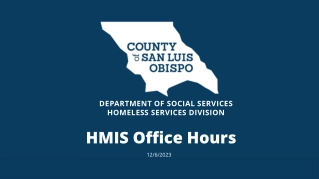Revamping Homeless Services: A Critical Look at System Planning and Coordination
The text highlights the challenges in the homeless sector due to fragmented services and separate funding streams for housing, social services, and health services. It emphasizes the inefficiencies and gaps in the current system, hindering efforts to help individuals exit homelessness. The case study of Calgary illustrates the significance of coordinated approaches like the Coordinated Access program, emphasizing the need for better coordination among agencies and programs to create an effective continuum of care for homeless individuals.
Uploaded on Nov 27, 2024 | 0 Views
Download Presentation

Please find below an Image/Link to download the presentation.
The content on the website is provided AS IS for your information and personal use only. It may not be sold, licensed, or shared on other websites without obtaining consent from the author.If you encounter any issues during the download, it is possible that the publisher has removed the file from their server.
You are allowed to download the files provided on this website for personal or commercial use, subject to the condition that they are used lawfully. All files are the property of their respective owners.
The content on the website is provided AS IS for your information and personal use only. It may not be sold, licensed, or shared on other websites without obtaining consent from the author.
E N D
Presentation Transcript
SYSTEM PLANNING By Nick Falvo, PhD Homelessness 101 Prepared for Canadian Housing & Renewal Association Apr 25, 2022
Overview Nichols & Doberstein 2016 Doberstein 2016 Calgary
Nichols & Doberstein 2016 In the book s introductory chapter, the co-editors note that a key problem in the homelessness sector is that most services and programs within this realm have been developed incrementally and have evolved in parallel: housing separate from social services which are separate from health services, corrections, mental health or employment and each has a separate funding stream...
Nichols & Doberstein 2016 The resulting patchwork of services can be replete with gaps and inefficiencies that undermine efforts to help citizens exit from homelessness, no matter how well each program may function individually (p. 9).
Nichols & Doberstein 2016 (contd) Writing about Calgary in the same book, Dressler notes: Prior to the implementation of [Calgary s coordinated access] program in 2013, the numerous homeless-serving agencies and programs in Calgary were operating relatively independently of one another, with little coordination regarding client intake or shared clients.
Nichols & Doberstein 2016 (contd) Agencies and programs in the system of care included emergency shelters and programs offering transitional housing, permanent housing, rapid rehousing, prevention, outreach, affordable housing and support services. Combined, they did not resemble a system, but rather a fragmented collection of agencies and programs...
Nichols & Doberstein 2016 (contd) Homeless individuals were often being served by multiple agencies and sat on multiple waitlists for housing, each of which was accessible only through the program itself. She continues
Nichols & Doberstein 2016 (contd) Not only was this fragmented system difficult for clients to navigate and potentially re-traumatizing because it required them to tell their story over and over again but agency and program accountability was also lacking. Agencies had the ability to refuse to serve clients based on their own assessment of programmatic fit, or if the client s needs were too complex. [The quote continues ]
Nichols & Doberstein 2016 (contd) This practice is known in the homeless-serving sector as cherry-picking or cream-skimming, i.e. picking clients who are easier to serve and thus more likely to be successful in agency programs and produce more positive outcomes. Agencies could assume that another agency or program would serve the client, but this left many clients under-served when in fact they were the clients requiring the most support.
Pushback Reasons people sometimes push back on creating a more efficient system planning framework: What s the point of doing all of this sophisticated system planning when need far outstrips supply in virtually all jurisdictions? Resources are required to undertake good system planning. This can detract from core supports.
Question for you Do those passages resonate with you?
Doberstein 2016 Doberstein: Calgary, Toronto and Vancouver differ dramatically in how they undertake system planning.
Doberstein 2016 (contd) According to Doberstein, multiple stakeholders play important roles in homelessness decision-making in both Vancouver and Calgary, more so than in Toronto. Vancouver and Calgary both have community advisory bodies that meet regularly and where members engage in important debate that leads to decisions pertaining to the disbursement of homelessness funding from the federal and provincial governments.
Doberstein 2016 (contd) By contrast, Toronto has a community advisory body that advises Toronto s municipal government on how to direct federal homelessness funding; however, it meets just once or twice a year, and essentially functions as a rubber stamp for the [municipal] bureaucracy s homelessness agenda (p. 95).
Calgary The Calgary Homeless Foundation (CHF) calls itself the System Planner for Calgary s Homeless-Serving System of Care (HSSC). This entails several functions, including disbursing approximately $50M annually to non-profits in Calgary s homeless-serving sector; monitoring performance of funded programs; identifying service gaps; brokering partnerships between non-profit entities in the homeless- serving sector; and facilitating community dialogue.
Thank you What s on your mind?























